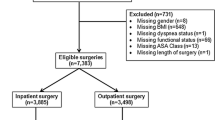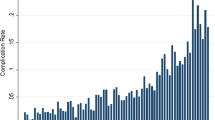Abstract
Background
Ankle fractures are common and can be associated with severe morbidity. Risk factors for short-term adverse events and readmission after open reduction and internal fixation (ORIF) of ankle fractures have not been fully characterized.
Questions/purposes
The purpose of our study was to determine patient rates and risk factors for (1) any adverse event; (2) severe adverse events; (3) infectious complications; and (4) readmission after ORIF of ankle fractures.
Methods
Patients who underwent ORIF for ankle fracture from 2005 to 2012 were identified in the American College of Surgeons National Surgical Quality Improvement Program (ACS-NSQIP®) database using International Classification of Diseases, 9th Revision and Current Procedural Terminology codes. Patients with missing perioperative data were excluded from this study. Patient characteristics were tested for association with any adverse event, severe adverse events, infectious complications, and readmission using bivariate and multivariate logistic regression analyses.
Results
Of the 4412 patients identified, 5% had an adverse event. Any adverse event was associated with insulin-dependent diabetes mellitus (IDDM; odds ratio [OR], 2.05; 95% confidence interval [CI], 1.35–3.1; p = 0.001), age ≥ 60 years (OR, 1.97; 95% CI, 1.22–3.2; p = 0.006), American Society of Anesthesiologists classification ≥ 3 (OR, 1.69; 95% CI, 1.2–2.37; p = 0.002), bimalleolar fracture (OR, 1.6; 95% CI, 1.08–2.37; p = 0.020), hypertension (OR, 1.47; 95% CI, 1.04–2.09; p = 0.031), and dependent functional status (OR, 1.47; 95% CI, 1.02–2.14; p = 0.040) on multivariate analysis. Severe adverse events occurred in 3.56% and were associated with ASA classification ≥ 3 (OR, 2.01; p = 0.001), pulmonary disease (OR, 1.9; p = 0.004), dependent functional status (OR, 1.8; p = 0.005), and hypertension (OR, 1.65; p = 0.021). Infectious complications occurred in 1.75% and were associated with IDDM (OR, 3.51; p < 0.001), dependent functional status (OR, 2.4; p = 0.002), age ≥ 60 years (OR, 2.28; p = 0.028), and bimalleolar fracture (OR, 2.19; p = 0.030). Readmission occurred in 3.17% and was associated with ASA classification ≥ 3 (OR, 2.01; p = 0.017).
Conclusions
IDDM was associated with an increased rate of adverse events after ankle fracture ORIF, whereas noninsulin-dependent diabetes mellitus was not. IDDM management deserves future study, particularly with respect to glycemic control, a potential confounder that could not be assessed with the ACS-NSQIP registry. Increased ASA class was associated with readmission, and future prospective investigations should evaluate the effectiveness of increasing the discharge threshold, discharging to extended-care facilities, and/or home nursing evaluations in this at-risk population.
Level of Evidence
Level III, prognostic study.
Similar content being viewed by others
References
American College of Surgeons. User Guide for the 2012 Participant Use Data File. American College of Surgeons National Surgical Quality Improvement Program. Available at: http://site.acsnsqip.org/wp-content/uploads/2013/10/ACSNSQIP.PUF_.UserGuide.2012.pdf. Accessed September 10, 2014.
Basques BA, Webb ML, Bohl DD, Golinvaux NS, Grauer JN. Adverse events, length of stay, and readmission following surgery for tibial plateau fractures. J Orthop Trauma. 2014 Aug 26 [Epub ahead of print].
Belmont PJ Jr, Goodman GP, Waterman BR, Bader JO, Schoenfeld AJ. Thirty-day postoperative complications and mortality following total knee arthroplasty: incidence and risk factors among a national sample of 15,321 patients. J Bone Joint Surg Am. 2014;96:20–26.
Brem H, Tomic-Canic M. Cellular and molecular basis of wound healing in diabetes. J Clin Invest. 2007;117:1219–1222.
Chaudhary SB, Liporace FA, Gandhi A, Donley BG, Pinzur MS, Lin SS. Complications of ankle fracture in patients with diabetes. J Am Acad Orthop Surg. 2008;16:159–170.
Costigan W, Thordarson DB, Debnath UK. Operative management of ankle fractures in patients with diabetes mellitus. Foot Ankle Int. 2007;28:32–37.
Dellenbaugh SG, Dipreta JA, Uhl RL. Treatment of ankle fractures in patients with diabetes. Orthopedics. 2011;34:385.
Golinvaux NS, Bohl DD, Basques BA, Baumgaertner MR, Grauer JN. Diabetes confers little to no increased risk of postoperative complications after hip fracture surgery in geriatric patients. Clin Orthop Relat Res. 2014 Sep 20 [Epub ahead of print].
Hanslow SS, Grujic L, Slater HK, Chen D. Thromboembolic disease after foot and ankle surgery. Foot Ankle Int. 2006;27:693–695.
Jones KB, Maiers-Yelden KA, Marsh JL, Zimmerman MB, Estin M, Saltzman CL. Ankle fractures in patients with diabetes mellitus. J Bone Joint Surg Br. 2005;87:489–495.
Kadous A, Abdelgawad AA, Kanlic E. Deep venous thrombosis and pulmonary embolism after surgical treatment of ankle fractures: a case report and review of literature. J Foot Ankle Surg. 2012;51:457–463.
Khuri SF, Henderson WG, Daley J, Jonasson O, Jones RS, Campbell DA Jr, Fink AS, Mentzer RM Jr, Neumayer L, Hammermeister K, Mosca C, Healey N. Successful implementation of the Department of Veterans Affairs’ National Surgical Quality Improvement Program in the private sector: the Patient Safety in Surgery study. Ann Surg. 2008;248:329–336.
Koga M, Murai J, Morita S, Saito H, Kasayama S. Comparison of annual variability in HbA1c and glycated albumin in patients with type 1 vs type 2 diabetes mellitus. J Diabetes Complications. 2013;27:211–213.
Korim MT, Payne R, Bhatia M. A case-control study of surgical site infection following operative fixation of fractures of the ankle in a large UK trauma unit. Bone Joint J. 2014;96:636–640.
Koval KJ, Zhou W, Sparks MJ, Cantu RV, Hecht P, Lurie J. Complications after ankle fracture in elderly patients. Foot Ankle Int. 2007;28:1249–1255.
Leininger RE, Knox CL, Comstock RD. Epidemiology of 1.6 million pediatric soccer-related injuries presenting to US emergency departments from 1990 to 2003. Am J Sports Med. 2007;35:288–293.
Mandi DM. Ankle fractures. Clin Podiatr Med Surg. 2012;29:155–186, vii.
Mayle RE Jr, DiGiovanni CW, Lin SS, Tabrizi P, Chou LB. Current concepts review: venous thromboembolic disease in foot and ankle surgery. Foot Ankle Int. 2007;28:1207–1216.
Menendez ME, Neuhaus V, Bot AGJ, Ring D, Johnson AH. The impact of metabolic syndrome on inpatient outcomes after isolated ankle fractures. Foot Ankle Int. 2014;35:463–470.
Miller AG, Margules A, Raikin SM. Risk factors for wound complications after ankle fracture surgery. J Bone Joint Surg Am. 2012;94:2047–2052.
Mizel MS, Temple HT, Michelson JD, Alvarez RG, Clanton TO, Frey CC, Gegenheimer AP, Hurwitz SR, Lutter LD, Mankey MG, Mann RA, Miller RA, Richardson EG, Schon LC, Thompson FM, Yodlowski ML. Thromboembolism after foot and ankle surgery. A multicenter study. Clin Orthop Relat Res. 1998;348:180–185.
Must A, Spadano J, Coakley EH, Field AE, Colditz G, Dietz WH. The disease burden associated with overweight and obesity. JAMA. 1999;282:1523–1529.
Nåsell H, Ottosson C, Törnqvist H, Lindé J, Ponzer S. The impact of smoking on complications after operatively treated ankle fractures—a follow-up study of 906 patients. J Orthop Trauma. 2011;25:748–755.
Ovaska MT, Makinen TJ, Madanat R, Huotari K, Vahlberg T, Hirvensalo E, Lindahl J. Risk factors for deep surgical site infection following operative treatment of ankle fractures. J Bone Joint Surg Am. 2013;95:348–353.
Sathiyakumar V, Molina CS, Thakore RV, Obremskey WT, Sethi MK. ASA score as a predictor of 30-day perioperative readmission in patients with orthopaedic trauma injuries: a NSQIP analysis. J Orthop Trauma. 2014 Jul 25 [Epub ahead of print].
SooHoo NF, Eagan M, Krenek L, Zingmond DS. Incidence and factors predicting pulmonary embolism and deep venous thrombosis following surgical treatment of ankle fractures. Foot Ankle Surg. 2011;17:259–262.
SooHoo NF, Krenek L, Eagan MJ, Gurbani B, Ko CY, Zingmond DS. Complication rates following open reduction and internal fixation of ankle fractures. J Bone Joint Surg Am. 2009;91:1042–1049.
Sporer SM, Weinstein JN, Koval KJ. The geographic incidence and treatment variation of common fractures of elderly patients. J Am Acad Orthop Surg. 2006;14:246–255.
US Department of Health and Human Services, Centers for Medicare & Medicaid Services (CMS). Hospital-level 30-day, all-cause risk-standardized readmission rate (RSRR) following elective primary total hip arthroplasty (THA) and/or total knee arthroplasty (TKA) (NQF #1551). Available at: www.qualityforum.org/WorkArea/linkit.aspx?LinkIdentifier=id&ItemID=72187. Accessed September 10, 2014.
Wukich DK, McMillen RL, Lowery NJ, Frykberg RG. Surgical site infections after foot and ankle surgery: a comparison of patients with and without diabetes. Diabetes Care. 2011;34:2211–2213.
Yoshiuchi K, Matsuhisa M, Katakami N, Nakatani Y, Sakamoto K, Matsuoka T, Umayahara Y, Kosugi K, Kaneto H, Yamasaki Y, Hori M. Glycated albumin is a better indicator for glucose excursion than glycated hemoglobin in type 1 and type 2 diabetes. Endocr J. 2008;55:503–507.
Author information
Authors and Affiliations
Corresponding author
Additional information
One or more of the authors (BAB) has received funding from the National Institutes of Health.
All ICMJE Conflict of Interest Forms for authors and Clinical Orthopaedics and Related Research ® editors and board members are on file with the publication and can be viewed on request.
Each author certifies that his or her institution approved or waived approval for the human protocol for this investigation and that all investigations were conducted in conformity with ethical principles of research.
Electronic supplementary material
Below is the link to the electronic supplementary material.
About this article
Cite this article
Basques, B.A., Miller, C.P., Golinvaux, N.S. et al. Morbidity and Readmission After Open Reduction and Internal Fixation of Ankle Fractures Are Associated With Preoperative Patient Characteristics. Clin Orthop Relat Res 473, 1133–1139 (2015). https://doi.org/10.1007/s11999-014-4005-z
Received:
Accepted:
Published:
Issue Date:
DOI: https://doi.org/10.1007/s11999-014-4005-z




